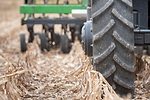Articles Tagged with ''soil health''
[Podcast] Soil Life Needs Food — Like Cover Crops
This week’s podcast, sponsored by GS3 Quality Seed, features Richard Purdin, Ag & Natural Resource Educator with The Ohio State University. Purdin will discuss factors to consider when starting out with cover crops, the economic benefits of cover crops, the soil health benefits of covers, and more.
Read More
[Podcast] Cover Crops Good Alternative to Fallow Fields in Dryland Systems
This week’s podcast, sponsored by Bio Till Cover Crops, features Augustine Obour, a soil scientist with Kansas State University. Obour will discuss using cover crops for soil health and forage in dryland systems, how cover crops use moisture in dryland growing systems, which cover crop species work best in arid climates, and more.
Read More
[Podcast] Rain is Like a Bomb Going Off on the Soil Surface
This week’s podcast, sponsored by Bio Till Cover Crops, features Jason Mallard, an Ag and Natural Resources Agent with University of Georgia Extension. Mallard will discuss the difference between water infiltration and percolation, how cover crops improve water quality, how cover crops protect the soil, and more.
Read More
Soil Health Benefits Top Reason Growers Planting Cover Crops
Results from the 2nd annual Cover Crop Strategies Benchmark Study show most growers aren’t paid for plant covers but still want to improve soil health.
Read More




